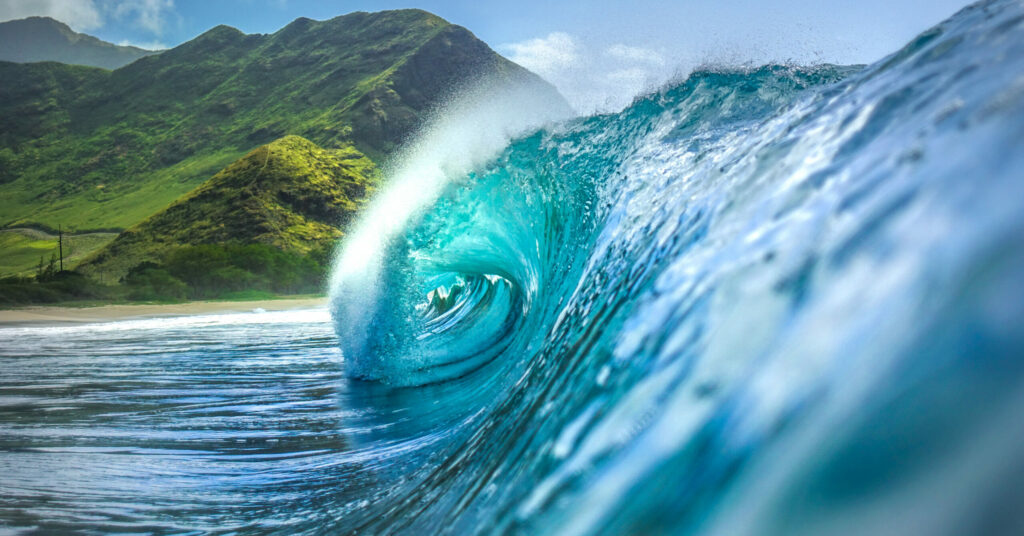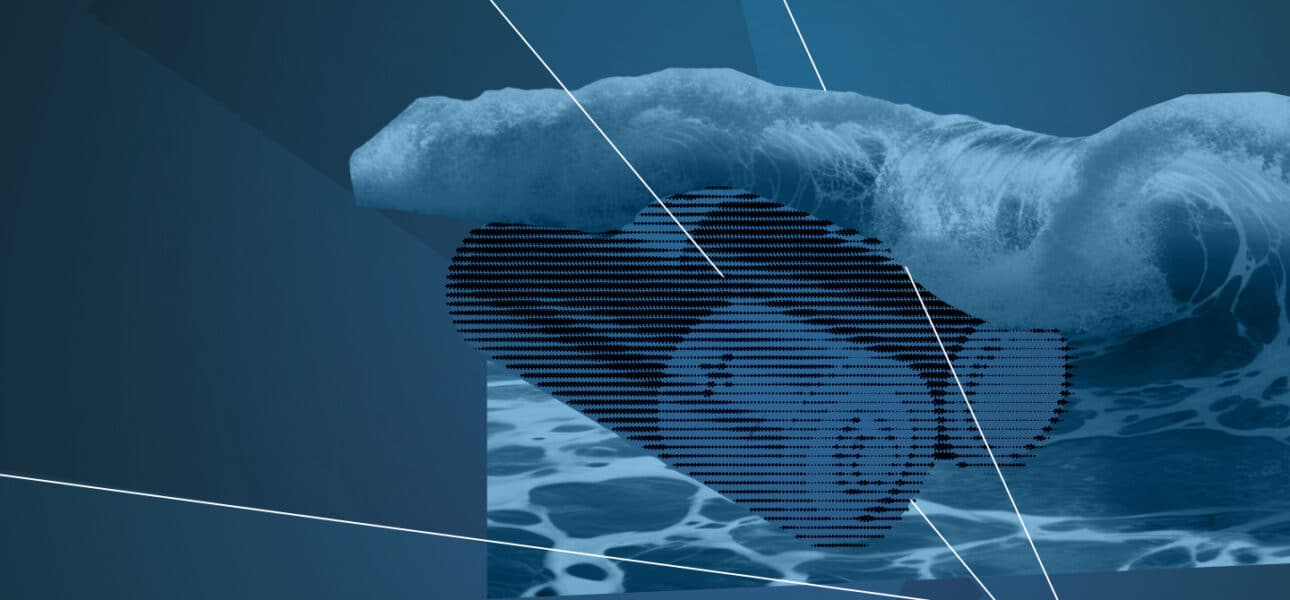What if the oceans could help limit global warming? Of course, reducing greenhouse gas (GHG) emissions is crucial. But balancing the quantities of CO2 emitted with those naturally absorbed – by plants, oceans, and soils – is a challenge at the current rate of human activity. Until this balance is achieved, the concentration of CO2 in the atmosphere will continue to rise. Anthropogenic capture of atmospheric CO2 is considered necessary by the Intergovernmental Panel on Climate Change (IPCC) to limit global warming to 2°C1. Existing solutions include reforestation, bioenergy with capture and storage, biochar spreading and ocean-based methods.
Ocean and CO2, a hidden potential
The ocean is a major natural carbon sink. In its latest report, the IPCC explains: “The oceans contain 45 times more carbon than the atmosphere, and ocean absorption has already consumed nearly 30–40% of anthropogenic carbon emissions”. CO2 is captured at the surface of the oceans by natural physical and chemical processes. Once dissolved, the carbon is transported by ocean currents to the deep oceans. Unfortunately, this phenomenon is not enough to compensate for the rapid increase in atmospheric CO2 concentration linked to human activities. “With the absorption of anthropogenic carbon, the surface ocean is rapidly becoming saturated and the processes that transport carbon to the deep ocean are not fast enough to compensate for the sharp rise in atmospheric concentrations,” explains Laurent Bopp. “As a result, the ocean now absorbs only 25% of our emissions”. Then there are the repercussions of climate change. “Certain effects are reducing the efficiency of the oceans: rising surface water temperatures, changes in ocean currents and a drop in phytoplankton production,” continues Laurent Bopp.
Today, the ocean only absorbs 25% of our emissions.
This led to the idea of “boosting” the oceanic pump. Since the late 1980s, the idea of fertilising phytoplankton with iron has been gaining ground. By increasing the productivity of these plants, carbon transport to the seabed is enhanced and the oceans can capture more atmospheric CO2. “Since the 2000s, the potential of this technique has been explored through modelling,” says Laurent Bopp. “Fertilising the oceans as a whole would be very inefficient in the face of anthropogenic emissions”.
“Alkalising water to raise the pH level”
Another major solution is the artificial alkalinisation of the oceans. “We are exploring the idea of re-alkalising the water to raise the pH, which would allow more atmospheric CO2 to be captured,” explains T. Alan Hatton. Alkaline mineral powders can be added to the ocean or electrochemical processes can be used. These techniques have the advantage of increasing the capture capacity of the oceans but also offsetting their ongoing acidification, which is harmful to ecosystems. “We are at an early stage of development, with research mainly in laboratories, although there are a few pilot-scale demonstrations”, summarises T. Alan Hatton. In early June, the MIT Technology Review2 revealed that Mike Schroepfer, former CTO of MetaPlatforms, had just set up an organisation (Carbon to Sea) dedicated to artificial alkalinisation. “We have less experience with alkalinisation than with fertilisation, and only a few experiments have been carried out near the coast – not in the open sea,” explains Laurent Bopp. At the University of California (UCLA), an institute dedicated to CO2 capture announced at the end of 20223 that it would be setting up two pilot systems in Los Angeles and Singapore via its start-up SeaChange. The process is based on the alkalinisation of water by electrolysis: the CO2 dissolved in the water is transformed into solid carbonate and/or aqueous bicarbonate4.

Meanwhile, a research team at the Massachusetts Institute of Technology (USA) has just developed a new alkalinisation process5 that it believes is effective and inexpensive. Electrolysis is also used, but the process does not use membranes or chemicals, which add to the cost and complexity of other electrolysis processes. In practice, the system is similar to a battery: an electric current flows between two electrodes. The electrodes are immersed in seawater, where they generate chemical reactions. The CO2 dissolved in the water is extracted in gaseous form and confined. The water is then alkalinised before being discharged. “The modules could be installed on stationary platforms at offshore wind or solar farms, or on cargo ships plying the seas, or integrated into onshore desalination processes […],” write the authors.
Once optimised, the system could capture a tonne of CO2 for $56. “We believe that it is possible to industrialise the process, even if a certain number of improvements are required beforehand”, explains T. Alan Hatton, co-author of the study. It should be noted that once the CO2 gas has been confined by the system, it still has to be “recovered”. It is possible to transform it into a synthetic fuel, or to store it long-term in geological reservoirs, processes that have not yet been implemented on a large scale.
Alkalinisation: time to take the plunge
Is artificial alkalinisation the solution for capturing residual anthropogenic emissions? The International Energy Agency estimates that it will be necessary to capture and store 7 gigatonnes of CO2 per year by 2050 in order to achieve carbon neutrality6. The US National Academy of Sciences puts the figure at 10 Gt per year7. According to the IPCC, the ocean is theoretically capable of storing thousands of gigatonnes of CO2 without exceeding pre-industrial levels of carbonate saturation if the fallout is distributed evenly over the ocean surface. Several studies estimate the storage potential of the oceans at a few Gt of CO2 per year, and modelling shows that it is possible to double the capture potential of the Mediterranean after 30 years of alkalinisation8. “It is vital to estimate and monitor the additional atmospheric CO2 absorbed by these techniques,” comments Laurent Bopp. But existing studies still contain a lot of uncertainties, and there is still very little known about the potential.
It is possible to double the capture potential of the Mediterranean after 30 years of alkalinisation.
Because of the higher concentration of CO2 in the oceans than in the atmosphere, the process is of major interest. “Unlike phytoplankton fertilisation, alkalinisation is based on physico-chemical processes, which are much better known than biological processes,” adds Laurent Bopp. Another advantage is that the process has no theoretical storage limits. “It is one of the key processes that regulates the climate on long time scales,” says Laurent Bopp. However, scientists still have little experience of these processes, which have been studied for several decades, and the ocean itself is a poorly understood system. The reinjection of alkaline water could counteract the harmful effects of ocean acidification, but the effects on ecosystems have been little studied. “It is important to ensure that alkalinised water is dispersed so as not to disrupt biodiversity,” concludes T. Alan Hatton. And we need to be aware of the impact of ocean water filtration on the local environment: retention of nutrients, local habitats, etc.”.









